#Triplehornring
Text
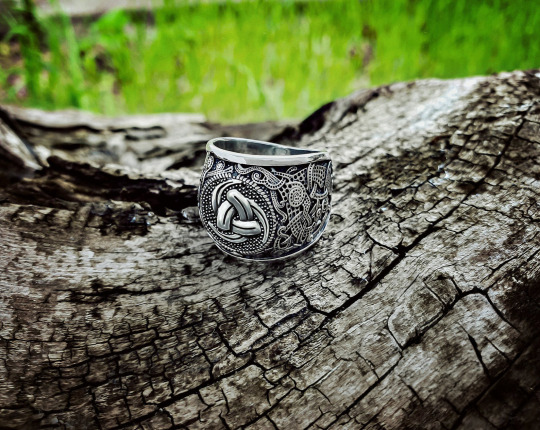
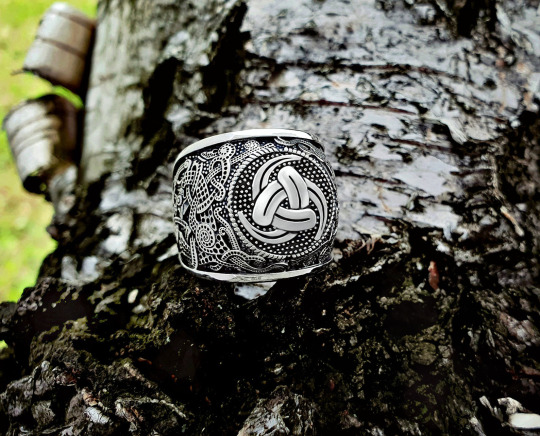

Odin horn ring
Metal: sterling silver (925)
Weight: approx. 17 g (0,59 oz)
Viking axe from Mammen.
In 1868 a farmer began to dig into the mound Bjerringhøj at Mammen near Viborg. During this work he chanced upon an unusually richly-furnished grave, which has become known as the grave from Mammen. A magnate was buried in the grave during the winter of 970-71 AD. He was given an expensive costume, a ceremonial axe with inlaid silver decoration and a large wax candle.
On one side a tree motif can be seen. It may symbolise the Christian Tree of Life or the pagan tree Yggdrasil. On the other side is an animal figure – perhaps the rooster Gullinkambi (Old Norse “golden comb”) or the Phoenix. According to Norse mythology Gullinkambi sits on top of the tree Yggdrasil. Here it wakes the Viking warriors every morning and it will crow at the beginning of Ragnarok (the end of the world).
The Triple Horn of Odin holds a sacred place as a symbol within the ancient Scandinavian Viking culture, representing the divine presence of the revered god Odin. This emblem, comprised of three interlocking horns, carries deep significance, embodying the strength, authority, and wisdom associated with Odin. Each horn, symbolizing the consumption of wine, serves as a tangible reminder of power and potency. Yet, beyond its physical representation, the Triple Horn of Odin encompasses a profound metaphor, signifying the eternal pursuit of knowledge and the unending thirst for discovery.
#vikingjewelry#exclusivejewelry#likeaviking#vikingstyle#norse#vikingring#ring#Triplehornring#Triplehorn#Odinring#handmade#silverring#Odin#Mammen#mammenstyle#silverjewelry#vikings#handmadejewelry#OdinHornRing#NorseJewelry#ScandinavianStyle#VikingAccessories#HandcraftedRing#OdinsBlessing#VikingCulture#MythologicalInspiration#NorseMythology#VikingArt#NordicDesign#HornSymbol
0 notes
Text
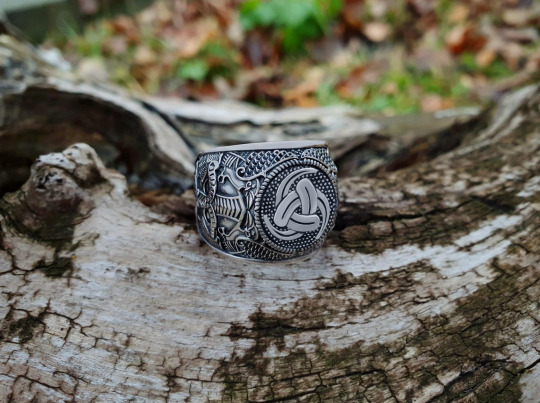
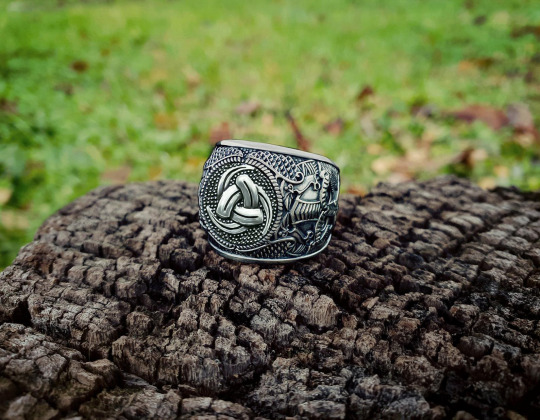


Odin horn ring
Metal: sterling silver (925)
Weight: approx. 17 g (0,59 oz)
Within the realm of Scandinavian Vikings, the Triple Horn of Odin reigned as a prominent pagan symbol, epitomizing the divine presence of the revered Norse deity, Odin. This emblem, comprised of three interlocking horns, held deep significance and served as a visual representation of Odin's might and sovereignty. The triple horn, commonly associated with wine, evoked connotations of strength and power, encapsulating the essence of Odin himself. Moreover, the symbol carried a profound message, embodying the relentless pursuit of wisdom, knowledge, and the thirst for discovery.
Steeped in ancient mythology, the origins of the Triple Horn of Odin can be traced back to the captivating saga surrounding Odin's quest for the legendary mead known as Odhroerir/Óðrerir, also known as the Mead of Poetry. The myth tells of a significant accord between the gods of Asgard and Vanhaem, aiming to resolve their conflicts through peaceful means. To solemnize this agreement, the divine beings contributed their saliva to a communal vat, giving rise to the awe-inspiring figure of Kvasir, renowned for his unparalleled wisdom and sagacity.
However, tragedy befell Kvasir when two conniving dwarves schemed his demise, extracting his life essence to create an extraordinary elixir. By combining the divine blood with honey, they fashioned a magical concoction capable of endowing those who partook in its consumption with the gift of poetry and wisdom. To safeguard this enchanted honey, the dwarves meticulously stored it within two vats named Son and Bodn, accompanied by a revered cauldron named Odrerir.
Driven by an insatiable quest for enlightenment, Odin, the supreme leader of the gods, embarked on a relentless journey to acquire this coveted honey. After an arduous search, he eventually stumbled upon the sacred cauldron, consuming its entire contents while simultaneously draining the two accompanying vats. Transfiguring into the majestic form of an eagle, Odin soared towards the celestial realm of Asgard, evading any potential threats or adversaries that might impede his pursuit.
This captivating myth left an indelible imprint upon Viking culture, permeating their customs and traditions. It ignited the popularity of mead, an intoxicating beverage crafted from the fermentation of honey and water, which became synonymous with their celebrations and rituals. Furthermore, the use of drinking horns became intrinsic to Viking practices, serving as vessels for the revered mead and playing a central role in ceremonial toasts. Consequently, Odin's triple horn became an iconic symbol, forever entwined with the transformative power of honey, embodying the realms of wisdom and poetic inspiration that it unlocked.
#vikingjewelry#exclusivejewelry#likeaviking#vikingstyle#norse#vikingring#ring#handmade#Odinmask#Odin#Triplehornring#Triplehorn#Odinring#Hugin#Munin#silverring#silverjewelry#vikings#handmadejewelry#OdinHornRing#NorseJewelry#ScandinavianStyle#VikingAccessories#HandcraftedRing#OdinsBlessing#VikingCulture#MythologicalInspiration#NorseMythology#VikingArt#NordicDesign
0 notes
Text
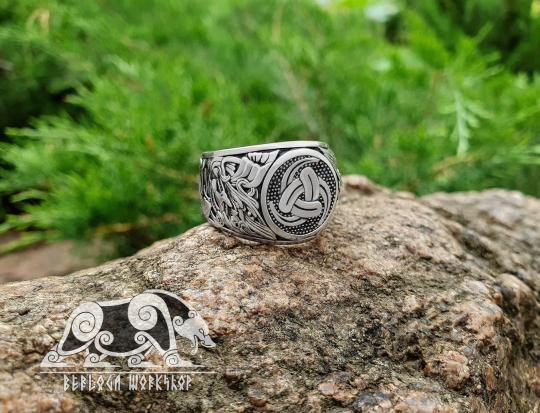
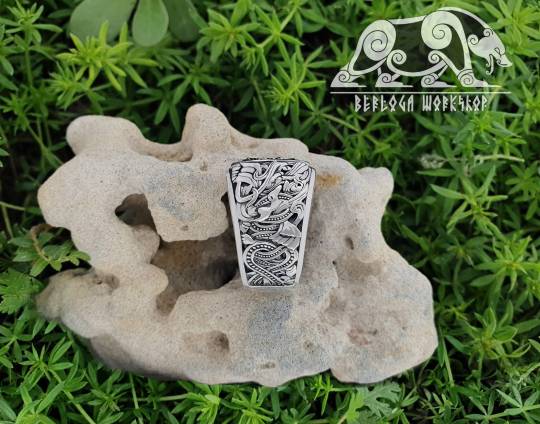
Triple horn of Odin ring (Borgund ring)
Design based on portal of stave church Borgund.
The Triple Horn of Odin is a stylized emblem of the Norse God Odin. This symbol consists of three interlocked drinking horns, and is commonly worn or displayed as a sign of commitment to the modern Asatru faith. The horns figure in the mythological stories of Odin and are recalled in traditional Norse toasting rituals. Most stories involve the God’s quest for the Odhroerir, a magical mead brewed from the blood of the wise god Kvasir.
The tales vary, but typically, Odin uses his wits and magic to procure the the brew over three days time; the three horns reflect the three draughts of the magical mead. Below is an image of the pre-Christian monument called the Larbro stone.
#berloga_workshop#vikingjewelry#exclusivejewelry#likeaviking#vikingstyle#norse#handmade#silverring#ornament#Borgundchurch#ring#vikingring#Odin#Triplehornring#Triplehorn#horn#Odinring#viking#Borgund
0 notes
Text

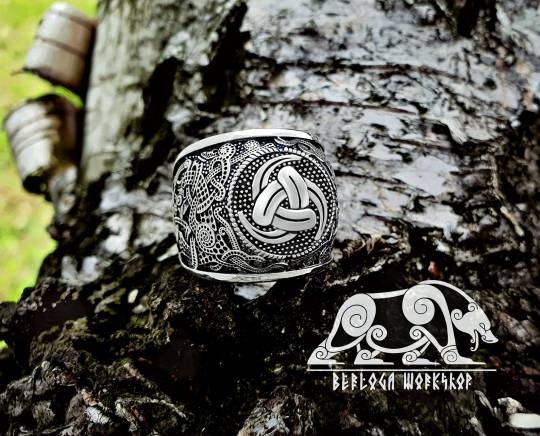
Triple horn of Odin ring (based on mammen axe)
The Triple Horn of Odin is a stylized emblem of the Norse God Odin. This symbol consists of three interlocked drinking horns, and is commonly worn or displayed as a sign of commitment to the modern Asatru faith. The horns figure in the mythological stories of Odin and are recalled in traditional Norse toasting rituals. Most stories involve the God’s quest for the Odhroerir, a magical mead brewed from the blood of the wise god Kvasir.
The tales vary, but typically, Odin uses his wits and magic to procure the the brew over three days time; the three horns reflect the three draughts of the magical mead. Below is an image of the pre-Christian monument called the Larbro stone.
#berloga_workshop#vikingjewelry#exclusivejewelry#likeaviking#vikingstyle#norse#vikingring#ring#Triplehornring#Triplehorn#Odinring#handmade#silverring#Odin#Mammen#mammenstyle#silverjewelry#vikings#handmadejewelry
0 notes
Text


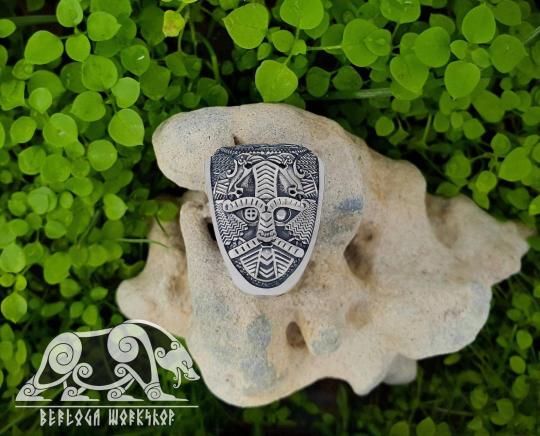
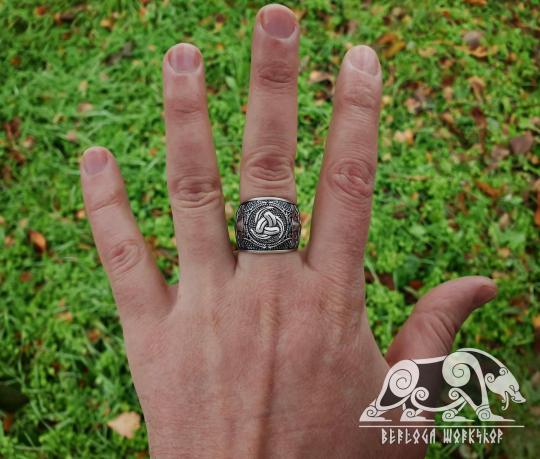
Triple horn of Odin ring (Odins mask ring)
The Triple Horn of Odin is a stylized emblem of the Norse God Odin. This symbol consists of three interlocked drinking horns, and is commonly worn or displayed as a sign of commitment to the modern Asatru faith. The horns figure in the mythological stories of Odin and are recalled in traditional Norse toasting rituals. Most stories involve the God’s quest for the Odhroerir, a magical mead brewed from the blood of the wise god Kvasir.
The tales vary, but typically, Odin uses his wits and magic to procure the the brew over three days time; the three horns reflect the three draughts of the magical mead. Below is an image of the pre-Christian monument called the Larbro stone.
In Norse mythology Odin is a god of war and death, as well as a sky god and the god of wisdom and poetry. He is also heavily associated with magic. Odin rides on an eight-legged horse called Sleipnir, and his famous spear is called Gungnir. He also has a precious arm ring called Draupnir, and two ravens called Hugin and Munin who tell him all the things happening around the world. Odin only has one eye, because he sacrificed one to drink from the fountain of wisdom.
#berloga_workshop#vikingjewelry#exclusivejewelry#likeaviking#vikingstyle#norse#vikingring#ring#handmade#Odinmask#Odin#Triplehornring#Triplehorn#Odinring#Hugin#Munin#silverring#silverjewelry#vikings#handmadejewelry
0 notes